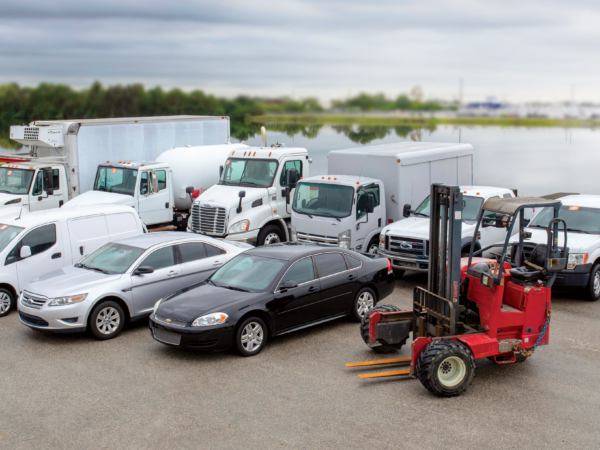
By Bill Bishop, SVP of Sales and Marketing, FLD
As part of our responsibilities as the leader in vehicle remarketing, FLD produces a quarterly report on the state of the used medium duty wholesale market called the White Metal Market Report. This publication, which is shared with our clients, partners and associates, is just one of the ways we demonstrate thought leadership in a corner of the fleet industry that has become overly populated with a host of independent and channel partners over the past few years. Ahead of the release of our Q3 report, we thought we’d share some of our most recent insights with the readers of Fleet Management Weekly.
Today – nearly a year and half since the start of the Covid 19 pandemic – the medium duty wholesale market is beginning to stabilize. And while much of the industry is still reeling from challenges like the ongoing chip and supply chain shortages, indications are that the wild ride is starting to moderate. And that at some point in the not-too-distant future, the medium duty wholesale market – and hopefully the entire fleet space – will find its new normal.
What makes us feel this way?
To begin with, the steep run-up we saw in used vehicle prices at the end of 2020 – and throughout the first half of 2021 – is most likely over. And while the price of wholesale used vehicles is roughly 25% higher than at the beginning of the year, we believe that while strong demand will continue, prices for these assets will begin to stabilize.
As we look back at 2021, there are several stark reminders that we’re entering a brave new age for the remarketing space.
For starters, it seems odd that we are solidly into the third quarter with little to no new inventory coming into the market. And while OEMs continue to do all they can to support dealers and major fleet clients, they’re still experiencing unprecedented production challenges that are hampering their ability to recover. As proof, Ford has stopped 2021 production of its flagship F-150 line, while GM has quit taking orders for certain new fleet vehicles for the rest of the year. And in a bizarre sign of the times, we have seen such previously unimaginable scenarios as hundreds of new Peterbuilt trucks sitting idle and undeliverable simply because there is no windshield glass available to install.
Going into the second half of the year, demand for medium duty trucks remains at all-time highs, driven by ravenous consumer demand, changes in service models, and the meteoric growth of final mile delivery. This strong demand for medium duty vehicles has also carried into Class 8 trucks, which basically have more buyers than available units, a situation we believe will continue well into 2022 and quite likely beyond.
Economic indicators sending mixed signals
As always, our team is paying close attention to the traditional economic indicators that have helped us stay abreast of the medium duty wholesale market for decades. And while areas of the economy continue to grow unchecked, many still languish due to a variety of challenges. This scenario has made predicting the future difficult. For example, the unemployment rate – while dropping – is still hard to decipher, especially when it appears that large segments of the population have yet to fully return to the workforce. It also seems hard to predict whether GDP will improve in the second half of 2021, although most indications are that it will.
As it has for much of the pandemic, housing remains a bright spot, and a strong driver of the economy. And while it appears that the out-of-control home prices we saw in the first half of the year have leveled off, few believe they will reverse course as inventory remains low, and buyers remain active. Ditto new construction, which is starting to pick up as materials costs for wood and concrete have fallen off the massive highs we saw in Q’s 1 and 2.
All of these factors lead us to believe the demand for work vehicles will continue, further limiting new vehicle inventory and pushing up prices for used assets. We also believe the mass migration fueled by the pandemic will further drive residential building and put an even higher premium on used work vehicles, especially across the South and West.
The energy sector continues to put pressure on the market, as instability in crude and fuel prices drive the cost of work truck services. Diesel is up almost a dollar a gallon in less than a year, with crude oil up 15-18% according to government statistics. And while pipelines seem to be moving, storm season has slowed production, making it difficult to predict how energy will affect the medium duty market over the rest of the year.
Finally, we believe the price of the US dollar is most likely having little effect on the wholesale space, as many companies seem flush with post-Covid cash, and are eager to spend. Meanwhile demand for vehicles is so strong that buyers seem willing to pay increasingly higher prices – further indicating that the dollar may be playing a smaller role in determining the trajectory of the industry than it has for at least a generation.
The future looks bright for resale
While intangibles like the chip and labor shortage, supply chain issues, and the lack of new vehicles continue to fog our crystal ball, we remain bullish on the used vehicle market. Not only for work units, but for passenger vehicles too, which continue to see huge demand as consumers loosen purse strings, and access to money remains abundant and cheap. This seems especially true for Japanese and German models, which continue to rule the used car market, further pushing American auto makers to the back of the line. Meanwhile, the pickup truck market continues to soften as only base models are being built. Of course, consumers can still order high-end trucks, but with little indication of when they’ll take delivery – yet another factor driving used vehicle prices. We’ve even heard anecdotal stories of vehicles that cost more used than they originally did new.
As it stands, the rental car companies have benefited from an extremely busy Summer but will slow – as usual – after Labor Day. We also don’t anticipate that they will sell vehicles until at least Q2 2022, further limiting access to units and driving up prices for used vehicles.
As was the case before the pandemic, the traditional van market is all but non-existent as Euro style models dominate the market and future orders, a phenomenon that will continue as American manufacturers switch to this body style.
Class 3-6 explodes
As the artisan and service industries continue to grow, so too will demand for class 3-6 vehicles. Right now, 3/4-ton pickups are the most popular and all but impossible to find, while 1-ton vehicles are a close second. This scenario is especially true of Class 6 vehicles, which are assuming much of the heavy work usually reserved for unavailable class 7-8 vehicles. Making these units more attractive is the fact they don’t require licensed CDL drivers, which – according to recent news reports – still remain in high demand with a shortage of at least 60,000 drivers according to experts. In fact, we are seeing many large trucking companies fighting to get new or near-new units as a way of attracting these in-demand drivers.
And finally, vocational trucks remain at critically low levels, with even long-established upfitters having a hard time finding the new vehicles they need to ramp up production.
Why there may never be a better time to remarket vehicles
With so much uncertainty, determining the best course of action for our customers has required painstaking research and an experienced eye. Nonetheless, we can emphatically say that in the four years we have been compiling our quarterly White Metal Market Report, we’ve never seen a more compelling time to remarket used vehicles and equipment.
For starters, FLD has been paying historically high prices for used vehicles, a fact that can help fleets significantly reduce a vehicle’s total cost of ownership. In addition, we have had many customers take advantage of our “zero days to sale” policy where we literally purchase their vehicles while they’re still in service and hand them a check the very day they come out. Still other customers are bringing us vehicles with sophisticated upfitting because they know – with more than 40 years of experience – we have the expertise to recognize their investment and pay top dollar instead of leaving them to the mercy of an auction or dealer who will sell their assets for whatever price they can get.
And finally, we like to remind sellers that with FLD, every transaction is totally risk free. That’s because we assume all risk of remarketing their vehicles by giving them an offer in hours – and payment the next day – so they can avoid hassles; save time, money and resources; and move on to more important things faster.
Looking forward to being back together!
As always, everyone here at FLD will continue to keep our ears to the ground and our eyes wide open so we can share important trends and predictions first. And like many of you, we’re certainly looking forward to seeing friends and industry colleagues as important events like AFLA and NAFA come back to life. In the meantime, we’ll keep doing what we do by keeping you informed, up to date and in the know as we make our way through the second half of 2021, and hope for even better things in 2022 and beyond.
 Bill Bishop is SVP of Sales and Marketing at FLD and a recognized expert on the medium duty wholesale market. You can reach him at [email protected], or by calling 1-800-754-1522 to learn more about our best-in-class remarketing services. And to receive a free copy of our quarterly White Metal Market Report, send us an email at [email protected] today.
Bill Bishop is SVP of Sales and Marketing at FLD and a recognized expert on the medium duty wholesale market. You can reach him at [email protected], or by calling 1-800-754-1522 to learn more about our best-in-class remarketing services. And to receive a free copy of our quarterly White Metal Market Report, send us an email at [email protected] today.



